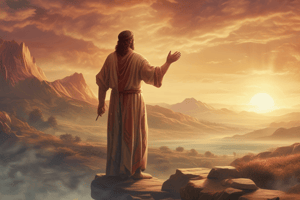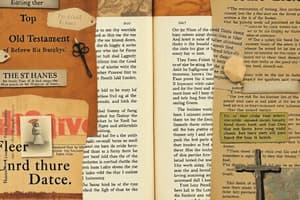Podcast
Questions and Answers
The story of the Tower of Babel is presented as a direct contrast to what core belief associated with Abraham?
The story of the Tower of Babel is presented as a direct contrast to what core belief associated with Abraham?
- The necessity of building monumental structures to honor deities.
- The importance of agriculture and settling in fertile lands.
- The establishment of a fixed canon of religious texts.
- The concept of a personal covenant with a single God. (correct)
Which of the following best describes the role of the Masoretes in preserving the Hebrew Bible?
Which of the following best describes the role of the Masoretes in preserving the Hebrew Bible?
- They discovered the Dead Sea Scrolls, providing early biblical texts.
- They added vowel markings and standardized the text to prevent alterations. (correct)
- They compiled the Apocrypha, adding additional books to the Old Testament canon.
- They translated the Hebrew Bible into Greek, creating the Septuagint.
The organization can be traced back to the three-fold division of the Hebrew Bible (Torah, Nevi'im, and Kethuvim). Which section includes the writings (Emeth, Magilloth, Post-Exilic)?
The organization can be traced back to the three-fold division of the Hebrew Bible (Torah, Nevi'im, and Kethuvim). Which section includes the writings (Emeth, Magilloth, Post-Exilic)?
- Nevi'im
- Septuagint
- Kethuvim (correct)
- Torah
The Protestant Old Testament contains 39 books, while the Roman Catholic Old Testament includes these 39 books in addition to other books. What is the name given to the additional books?
The Protestant Old Testament contains 39 books, while the Roman Catholic Old Testament includes these 39 books in addition to other books. What is the name given to the additional books?
Which of the following statements correctly connects a specific Old Testament version or translation to its defining characteristic?
Which of the following statements correctly connects a specific Old Testament version or translation to its defining characteristic?
What is the correct chronological ordering of the fixation of the Torah, Nevi'im, and Kethuvim?
What is the correct chronological ordering of the fixation of the Torah, Nevi'im, and Kethuvim?
The concept of a 'covenant' is central to understanding the Old Testament. What best describes its significance?
The concept of a 'covenant' is central to understanding the Old Testament. What best describes its significance?
What is the primary language in which the Old Testament was originally written?
What is the primary language in which the Old Testament was originally written?
In the context of Leviticus, what concept does 'Kippur' specifically represent?
In the context of Leviticus, what concept does 'Kippur' specifically represent?
How did the holiness of God primarily affect the Israelite community, according to Levitical principles?
How did the holiness of God primarily affect the Israelite community, according to Levitical principles?
What was the primary role of priests within the sacrificial system?
What was the primary role of priests within the sacrificial system?
What critical function did the clean and unclean laws serve within the Israelite community?
What critical function did the clean and unclean laws serve within the Israelite community?
The 'Holiness Code' in Leviticus served what main purpose for the Israelites?
The 'Holiness Code' in Leviticus served what main purpose for the Israelites?
What was the key element of the Nazirite vow regarding the consumption of grapes and grape products?
What was the key element of the Nazirite vow regarding the consumption of grapes and grape products?
In the book of Numbers, what was the primary reason for conducting a census of the Israelite population?
In the book of Numbers, what was the primary reason for conducting a census of the Israelite population?
What was a significant consequence of the first generation's rebellion and refusal to enter the Promised Land, as described in Numbers?
What was a significant consequence of the first generation's rebellion and refusal to enter the Promised Land, as described in Numbers?
What lesson is highlighted by Moses' own disobedience in the book of Numbers?
What lesson is highlighted by Moses' own disobedience in the book of Numbers?
What is the primary significance of the Oracles of Balaam in the book of Numbers?
What is the primary significance of the Oracles of Balaam in the book of Numbers?
What is the overarching structure of the book of Deuteronomy based on?
What is the overarching structure of the book of Deuteronomy based on?
What critical purpose does Deuteronomy serve for the second generation of Israelites?
What critical purpose does Deuteronomy serve for the second generation of Israelites?
What is the significance of identifying with previous generations in Deuteronomy?
What is the significance of identifying with previous generations in Deuteronomy?
What is a key theological message conveyed through revisiting the Ten Commandments in Deuteronomy?
What is a key theological message conveyed through revisiting the Ten Commandments in Deuteronomy?
According to the Deuteronomic formula, what is the relationship between the Israelites' actions and their fate?
According to the Deuteronomic formula, what is the relationship between the Israelites' actions and their fate?
Which of the following statements best encapsulates the unifying theme of the Torah as presented in Genesis 12:1-3?
Which of the following statements best encapsulates the unifying theme of the Torah as presented in Genesis 12:1-3?
Which of the following sets of promises were made to Abraham as part of God's covenant?
Which of the following sets of promises were made to Abraham as part of God's covenant?
How is it traditionally understood that the Torah can be divided into two main sections?
How is it traditionally understood that the Torah can be divided into two main sections?
According to tradition, who is considered the author of the Torah?
According to tradition, who is considered the author of the Torah?
What is the central claim of the Classic Documentary Hypothesis regarding the composition of the Torah?
What is the central claim of the Classic Documentary Hypothesis regarding the composition of the Torah?
The English title 'Genesis' and the Jewish title both share a similar meaning. From where do these titles originate?
The English title 'Genesis' and the Jewish title both share a similar meaning. From where do these titles originate?
How does the Tower of Babel narrative relate to the Abrahamic covenant described in Genesis 12?
How does the Tower of Babel narrative relate to the Abrahamic covenant described in Genesis 12?
In the context of Genesis, what is the primary function of the clean and unclean laws?
In the context of Genesis, what is the primary function of the clean and unclean laws?
What critical role does the Joseph story play in the broader narrative of Genesis?
What critical role does the Joseph story play in the broader narrative of Genesis?
What is the significance of the name Yahweh, revealed in Exodus, in understanding God's character?
What is the significance of the name Yahweh, revealed in Exodus, in understanding God's character?
How does the concept of the Suzerain-Vassal Treaty structure the covenant relationship between God and Israel in Exodus?
How does the concept of the Suzerain-Vassal Treaty structure the covenant relationship between God and Israel in Exodus?
Why did Moses break the tablets containing the Ten Commandments and what did it signify?
Why did Moses break the tablets containing the Ten Commandments and what did it signify?
What does the Passover commemorate in the context of the Exodus narrative?
What does the Passover commemorate in the context of the Exodus narrative?
What is the primary purpose of the book of Exodus?
What is the primary purpose of the book of Exodus?
What was the basic purpose and function of the Tabernacle?
What was the basic purpose and function of the Tabernacle?
Flashcards
Apocrypha
Apocrypha
Means 'hidden'; refers to books not included in the Hebrew Bible canon.
Canon
Canon
Originally meant 'reed'; later, a standard or measuring stick for scripture.
Leningrad Codex
Leningrad Codex
The oldest complete copy of the Hebrew Bible.
Septuagint
Septuagint
Signup and view all the flashcards
Masoretes
Masoretes
Signup and view all the flashcards
Covenant
Covenant
Signup and view all the flashcards
Torah
Torah
Signup and view all the flashcards
Pentateuch
Pentateuch
Signup and view all the flashcards
Apodictic Law
Apodictic Law
Signup and view all the flashcards
Casuistic Law
Casuistic Law
Signup and view all the flashcards
Kippur
Kippur
Signup and view all the flashcards
Sabbath Day
Sabbath Day
Signup and view all the flashcards
Sabbath Year
Sabbath Year
Signup and view all the flashcards
Jubilee Year
Jubilee Year
Signup and view all the flashcards
Purpose of Leviticus
Purpose of Leviticus
Signup and view all the flashcards
Goal of Sacrificial System
Goal of Sacrificial System
Signup and view all the flashcards
Basic Sacrifices
Basic Sacrifices
Signup and view all the flashcards
Purpose of Priest
Purpose of Priest
Signup and view all the flashcards
Purpose of Clean and Unclean Laws
Purpose of Clean and Unclean Laws
Signup and view all the flashcards
Purpose of Yom Kippur
Purpose of Yom Kippur
Signup and view all the flashcards
Purpose of Holiness Code
Purpose of Holiness Code
Signup and view all the flashcards
Significance of Numbers' Titles
Significance of Numbers' Titles
Signup and view all the flashcards
Nazarite Vow
Nazarite Vow
Signup and view all the flashcards
Torah's Unifying Theme
Torah's Unifying Theme
Signup and view all the flashcards
Abraham's Three-Fold Promise
Abraham's Three-Fold Promise
Signup and view all the flashcards
Documentary Hypothesis
Documentary Hypothesis
Signup and view all the flashcards
Enuma Elish
Enuma Elish
Signup and view all the flashcards
Elohim
Elohim
Signup and view all the flashcards
Protevangelium
Protevangelium
Signup and view all the flashcards
Gilgamesh Epic
Gilgamesh Epic
Signup and view all the flashcards
Circumcision
Circumcision
Signup and view all the flashcards
Basic outline of Genesis
Basic outline of Genesis
Signup and view all the flashcards
Purpose of Genesis
Purpose of Genesis
Signup and view all the flashcards
Tower of Babel vs. Abraham
Tower of Babel vs. Abraham
Signup and view all the flashcards
Theme amid Covenant Challenges
Theme amid Covenant Challenges
Signup and view all the flashcards
Significance of covenant ceremony in chapter 15
Significance of covenant ceremony in chapter 15
Signup and view all the flashcards
Moses
Moses
Signup and view all the flashcards
Passover
Passover
Signup and view all the flashcards
Study Notes
- The Tower of Babel story is the direct opposite of Abrahamic beliefs.
Key Definitions
- Apocrypha: Hidden writings.
- Canon: Originally "reed," later signifying a ruler or measuring stick.
- Covenant: A treaty or testament; the relationship between God and His people.
- Torah: Means "instruction" and is translated as "law."
- Pentateuch: Means "Five Scrolls" of the torah.
Key Documents
- Leningrad Codex: The oldest complete manuscript of the Hebrew Bible.
- Samaritan Pentateuch: The Samaritans' version of the Torah.
- Septuagint: Greek translation of the Hebrew Bible.
- Targumim: Aramaic paraphrases of the Old Testament.
- Vulgate: Latin translation originally done by Jerome.
- Dead Sea Scrolls: Scrolls containing nearly all of the Old Testament, found in a cave near the Dead Sea in the late 1940s.
Key People
- Adam and Eve: The first man, made from dust, and woman, created from Adam's rib.
- Abraham: God willed him to "leave".
- Isaac: Son of Abraham.
- Jacob: Son of Isaac.
- Joseph: Jacob's favorite son.
- Moses: Led the Israelites from Egypt, received the Ten Commandments.
- Joshua: Moses' successor, led the Israelites into the Promised Land.
Key Places
- Fertile Crescent: Fertile land area in the Middle East from the Nile to the Tigris and Euphrates.
- Mt. Sinai/Horeb: The location where God gave Moses the Ten Commandments.
Hebrew Bible Sections
- Torah: The law, received by Moses, considered authoritative.
- Nevi'im: The Prophets (former and latter).
- Kethuvim: The Writings.
Canonisation Timeline
- Torah fixed by: 400 BC
- Nevi'im fixed by: 200 BC
- Kethuvim fixed by: 100 AD
Bible Book Count
- Hebrew Bible in the Old Testament: 24 books.
- Protestant Bible in the Old Testament: 39 books.
- Roman Catholic Bible in the Old Testament: 39 books + Apocrypha.
Language
- The Old Testament was primarily written in Hebrew.
Genesis: Beginnings
- English and Jewish Title means: "Beginnings," originating from the Septuagint and the first words of Genesis, respectively.
- Genesis 1-11: Primeval History.
- Genesis 12-50: Patriarchal History.
- Purpose: Explains the beginning of the Covenant story.
The Fall
- Intensification of violence and rebellion against God.
Noachic Covenant
- Judgment: God undoing creation in reverse.
- Grace: God preserving His image through Noah, reestablishing the covenant.
Abrahamic Covenant
- Three-fold promise to Abraham: a great nation, a great name, and blessing.
- Royal Land Grant Treaty: King guarantees the land, offers tax relief for obedience and ensures the land stays in the family.
- Circumcision: Signified Abraham's covenant with God.
- The underlying theme to challenges to the covenant: God provides a way for it to continue.
- Climax to the challenges to the covenant: Sacrifice of Isaac
Jacob's Covenant
- Name Change: God's control of his promise.
- Wrestling with God demonstrates: God reassures Jacob of the covenant blessing.
Joseph's Covenant
- Proves that God finds a way for the covenant to continue.
Exodus
- Exodus: Means "the way out."
- Yahweh: "I am who I am."
- Purpose: To explain how the Israelites became slaves and how God delivered them from Egyptian oppression.
- Two Possible Dates: Early date - 1450 BC, Late date - 1250 BC.
- Three Major Events: Deliverance, Covenant, God's Presence.
- Traditional Route: Southern Route.
Exodus - Key Concepts
- "Ten Words": A summary of law based on covenant.
- Ten Words Synonyms: Ten Commandments, Decalogue
- Theological Significance of the "Ten Plagues": a battle between God and false gods.
- The concept of "First Born": Justice being reiterated from Pharaoh killing the firstborn males of Israel.
- Suzerain-Vassal Treaty: Vassal obeys stipulations for protection from Suzerain.
- Tabernacle: Build at Lord's instruction from a pattern shown to Moses
Sinai Covenant
- It means full communion with God where God will dwell among his people
Golden Calf
- Conveyed that the people had broken the covenant but then he restores order
Leviticus - Holiness Code
- The book pertains to the Levites.
- Spatial Gradation: Holiness of people and things dependent on relationship to Holiness of God
- Purpose: Instruct the sinful Hebrew community in holiness for living with and worshiping a holy God.
- Goal: Holiness.
- Need: Forgiveness.
- Impact of God's Holiness: Gradation (sacrifices) and Fellowship (communion with God).
Laws
- Apodictic Law: Direct command; unconditional; universal.
- Casuistic law: Example case; conditional; specific as guideline.
- Clean and Unclean law: prevent the unclean from coming in contact with, and contaminating, the clean and holy
Rituals
- Kippur: Removal of sin (expiation).
- Sabbath day: weekly ordinance that reminded Israel Yahweh was the Creator
- Sabbath year: every 7th year the land was to lie fallow
- Jubilee year: every 50th year property reverted back to the families of its original owners
- Overall goal of the sacrificial system: full communion and worship of God
- Priests: Were to present the people in the presence of God by offering sacrifices
- Yom Kippur: Day to commemorate the removal of sin and guilt as Go gives forgiveness
Numbers
- Two numberings appear in the book.
- Significant about the English and Hebrew title: English- From LXX, Hebrew- From first words
- Three Basic Divisions:
- Ch 1-10 (Sinai- preparing army).
- Ch 11-25 (wilderness- rebellion).
- Ch 26-36 (Moab- preparing 2nd army).
- Purpose of census: Battle/conquest and division of land.
Key People in Numbers
- Joshua and Caleb: Spies that showed faith who said God help them re-conquer the promised land
- Balaam: Non-Israelite "seer"
- Balak: King of Moab
Nazarite Vows
- A vow consisting of three parts: No fruit of the vine, No razor on head, and Not touch dead body.
First Army Rebellion
- Entire generation suffered consequences of rebellion because lf their Lack of faith
- Moses' Own Disobedience: Leaders bear greater responsibility.
New Testament Analogy
- Fiery serpent episode provides an analogy for understanding context of John 3:16.
Balaam Covenant
- To make clear to the people that the Lord is committed to Israel and the Abrahamic covenant
Deuteronomy Meaning
- Means "second law"
- Significant about the English title: It's a better translation of the 2nd law and is a restatement of the law for the Israelites
- Structure/outline of the book based on: three speeches that Moses and similar to ANE Suzerain-Vassal Treaty
- Serves as a constitution for the 2nd generation Israelites
Key People in Deuteronomy
- Joshua: Moses' successor
- Significance about identifying with previous generations: People of God viewed as a continuum
- Significance about the Shema it confirms that the essence of the law is love for God and neighbor
The Ten Commandments in the Book of Deuteronomy
- They are given to the 2nd generation
Other Info About Deuteronomy
- Basis of Israel's election: Call of Abraham and stressed in call of Moses and Sinai covenant
- Deuteronomic formula: Obedience brings blessing and disobedience brings judgment
Studying That Suits You
Use AI to generate personalized quizzes and flashcards to suit your learning preferences.




